Barred Rocks, a popular breed of chicken, are known for being friendly and having good egg layers. If you’re raising Barred Rocks, you might be wondering when do Barred Rock chickens start laying eggs. Typically, these chickens begin laying eggs around 18 to 20 weeks of age.
However, the exact timing can vary depending on factors like diet, environment, and overall health. Knowing what to expect can help you be prepared when your Barred Rocks start giving you fresh eggs. Let’s talk about everything you need to know about this fun breed.
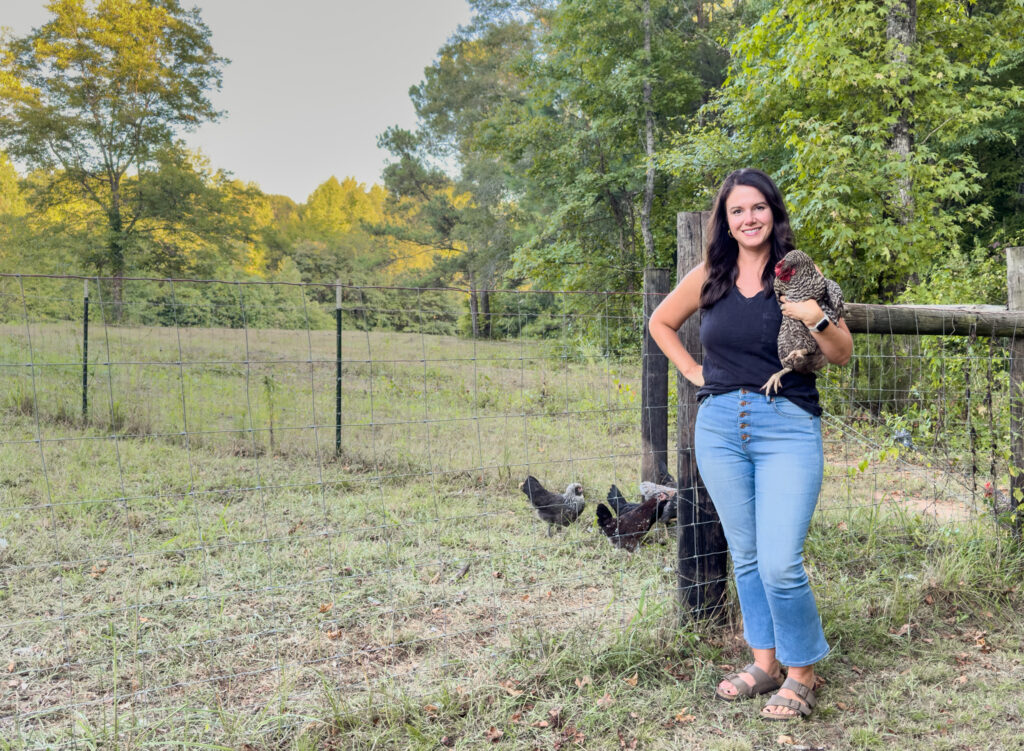
Contents
- Physical appearance
- Disposition
- Egg laying abilities
- Housing requirements
- Meat Quality
- Climate conditions
- Feed Needs
- Heritage Qualities
- Health Issues
- Barred Rock Chicks
- History of the Barred Plymouth Rock
Barred Rock
The first breed of chickens I ever owned were Barred Rocks from Tractor Supply, and I instantly fell in love with them. These larger breed chickens are so hardy and have sweet personalities that make them easy to care for.
I bought my first chickens in the early fall expecting eggs by Christmas. After a while I started to wonder when do barred rock chickens start laying eggs? Turns out it takes a while before they are mature enough to lay. When they finally did, they’ve been great layer since!
Barred Rocks are known for consistent egg production, making them one of the best chickens for laying eggs regularly. Even though I now own around 28 different breeds of chickens, Barred Rocks are still my favorite.
They’re such a good choice for anyone starting out, and they’ll quickly become a favorite on your farm too. Whether you’re just beginning or have experience with different breeds of chickens, you really can’t go wrong with Barred Rocks.
Other Chicken Articles You’ll Love
- Best Traits of Easter Egger Chickens: A Simple Guide
- What Time Do Chickens Go To Bed? Roosting Habits
- Why Do Chickens Scratch and Peck The Ground?
- The 18 Best Incubators For Hatching Chickens
- How Do Chickens Clean Themselves
*This post may contain affiliate links which means I make a small commission at no extra cost to you. Read my full disclosure here.*
Physical appearance of Barred Rock Chickens
Barred Rocks are a very noble and thick breed, with a strong, sturdy build that makes them stand out. Roosters weigh an average of 9 pounds while hens weigh around 7 pounds. They have large breasts with yellow skin and bare yellow legs and feet, which are common traits of this breed.
The beautiful feathering on Barred Rock hens and roosters consists of black, white, and gray barring, giving them a distinct and unique look that’s easy to recognize. The males, or rock roosters, have a striking spray and full tail, making them especially eye-catching.
Their single comb adds a nice pop of color to their overall appearance. This barred chicken truly fits the breed standard for Plymouth Rocks, with a combination of white feathers and dark barring that sets them apart from other chickens.
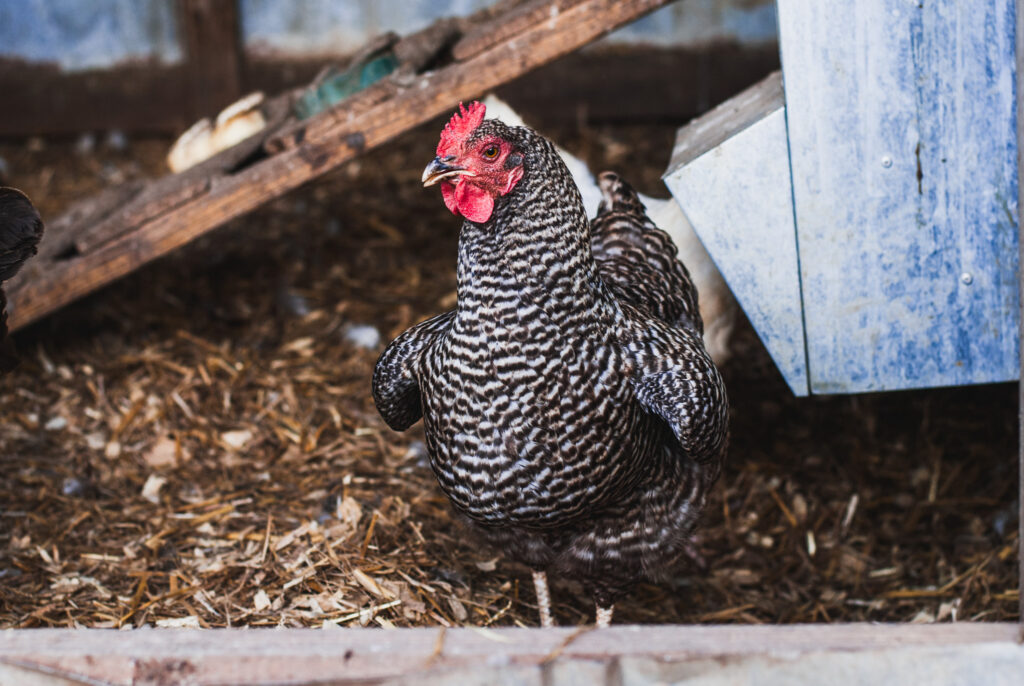
Disposition
Barred Rock chickens have a calm and curious disposition, making them one of the best chicken breeds to have around. The roosters are especially alert protectors, always on the lookout for predators and keeping the flock safe.
While they are great with their human companions, they can sometimes be bullies in the coop. Barred Rock hens tend to rise to the top of the pecking order, which can lead to some bossiness, especially toward younger hens and new chicks.
If you’re not careful, they can also be prone to feather picking, so it’s important to monitor their behavior. Plymouth Rock hens might not do well in a flock with much younger chickens, as they may pick on them.
Despite these challenges, their overall temperament and protective nature make them a favorite among many chicken keepers.
When Do Barred Rock Chickens Start Laying Eggs?
Barred Rock chickens are excellent layers, and I’ve always been impressed by their egg production. The hens have a heavy body with a round, low belly, which is often a sign of a good layer.
They produce medium to large brown eggs, and sometimes the bloom on the eggs gives them a beautiful pinkish tint. Barred Rocks usually start laying their first egg around 18 to 20 weeks of age, but I’ve raised a fall flock that took longer due to the shorter daylight hours.
These hens can lay around 200-250 eggs a year, and with good care, many of mine have laid consistently for 3+ years. Some of my Barred Rocks even keep laying through the winter months, which is a bonus when egg counts typically drop.
With their strong laying abilities, Barred Rocks are a great choice for anyone looking for dependable egg production.
Housing Requirements for Barred Rocks
Barred Rock chickens are a larger, heavier breed, so they need plenty of space to stay happy and healthy. If they have access to outdoor space, they’ll need at least 4 square feet per bird inside the chicken coop. Without outdoor access, you’ll want to provide at least 10 square feet per bird.
If your Barred Rocks can free range, you can get by with just 2 square feet of coop space per bird since they’ll spend most of their time outside. While they can be kept in a coop, they’re happiest when they have room to roam and do best when not contained all day.
Make sure your coop is predator-proof, as predators can find ways in if you’re not careful. Hardware cloth is a better option than chicken wire, and you should bury the wire under the ground around the coop to prevent digging predators.
Barred Rocks also need good ventilation in the coop, but it’s important to keep it draft-free, especially during the winter. Learn more about chicken coop size and space requirements.
Don’t forget to provide nest boxes, with one box for every 3-4 chickens, so your backyard flock has a cozy spot to lay eggs, even during the summer months. Check out my favorite nesting boxes!
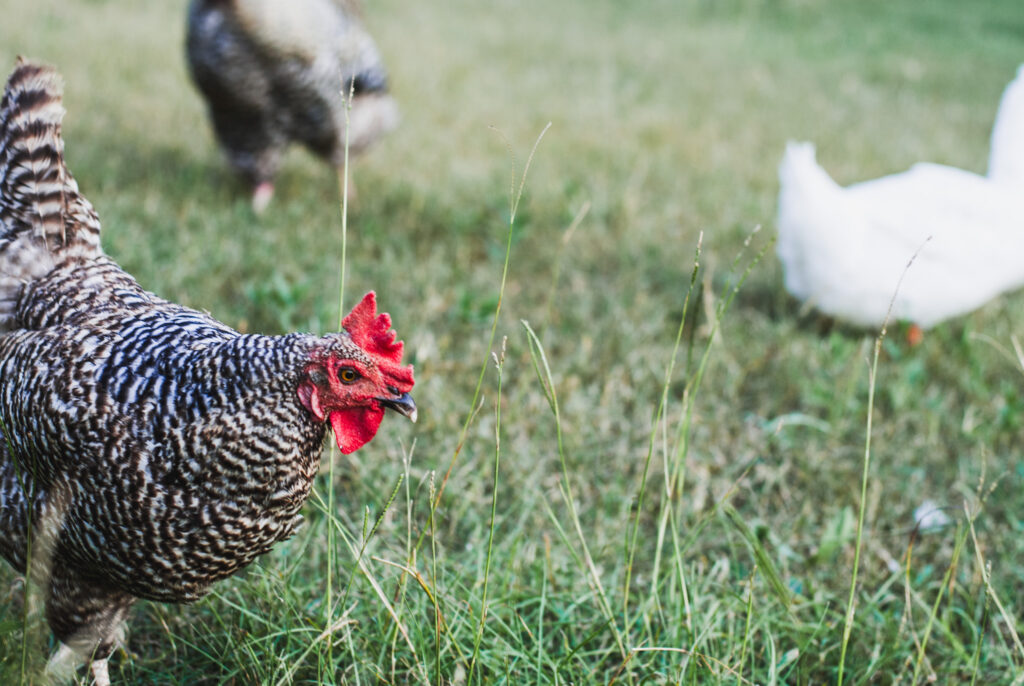
Meat Quality
Barred Rocks are an excellent choice if you’re looking for a dual-purpose bird. They have full bodies of tender meat, making them great for both eggs and meat production. These large birds will reach harvest size in about 18 weeks, with a 3-4 pound carcass.
While they don’t have the large breasts of their hybrid cousins, like the Cornish Rock Cross, they make up for it with juicy dark meat that’s full of flavor. The Cornish Rock Cross, a well-known meat bird, is actually a hybrid of the Plymouth Rock, specifically the White Plymouth Rock.
This breed has been recognized for its exceptional meat quality for a long time. Barred Rocks, with their docile nature and good meat, are a solid choice for anyone wanting to raise dual-purpose birds.
Ideal Climate Conditions for Barred Rock Chickens
Barred Rock chickens are hardy in most climates, making them a good choice for various environments. Here in the Deep South, where it’s hot and humid, they do just fine, but their tighter feathering might not be ideal for places like South Florida or other tropical climates.
In warm weather, it’s important to provide them with a well-ventilated but draft-free coop, as I mentioned earlier, especially during the winter months.
To keep them cool during the hot summer, make sure they have access to the outdoors, plenty of fresh water, and shade. You might even consider using kiddie pools filled with water to help them cool off.
Both older hens and younger birds will appreciate the extra effort. If you’re concerned about heat strokes in chickens, be sure to check out my previous post for more information.
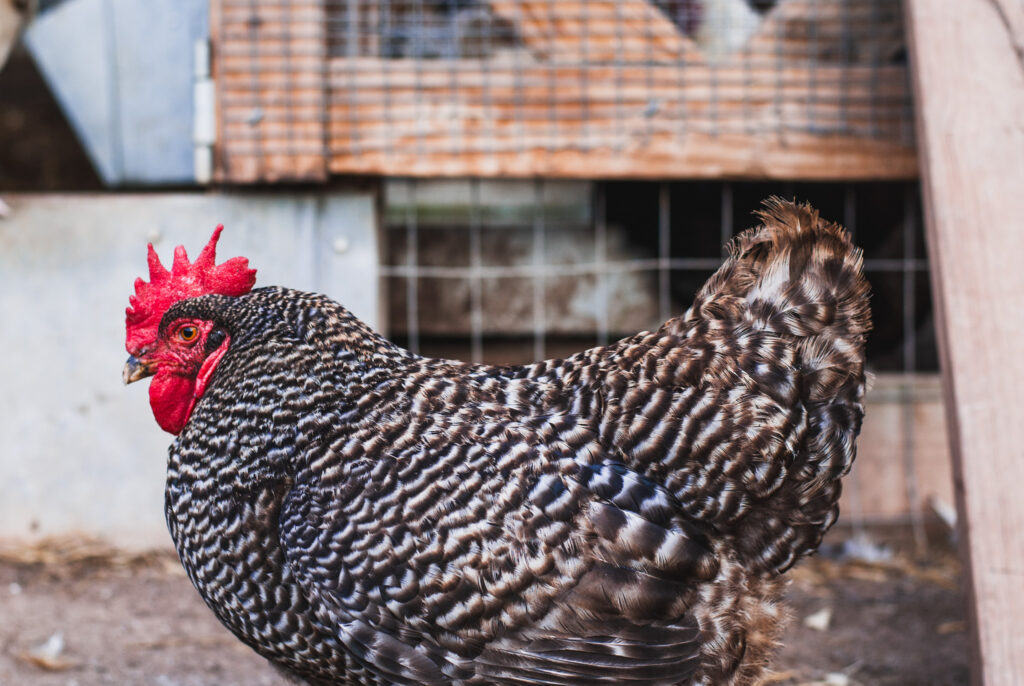
Barred Rock Feed Needs
Barred Rock chickens have specific feed needs depending on their age. When they’re new chicks, they require around 22% protein to help them grow strong and healthy. It’s important not to feed young birds layer feed too early, as it has too much calcium and can lead to serious health problems. Instead, you can keep them on starter or grower feed until they’re ready to lay eggs.
Once they reach laying age, around 18-20 weeks, you can switch them to complete layer feed, which has about 4% calcium to support healthy eggs. During stages like molting, you might want to add protein supplements to their diet, and my previous post on the best protein for chickens can help with that.
During peak laying season, your hens may need some extra calcium, so providing oyster shells is a good way to boost their levels and keep them laying strong. For more tips on feeding your flock, be sure to check out my previous post on chicken grit.
A well-fed laying hen will produce more eggs, while a young hen on the wrong diet might end up laying fewer eggs or even having health issues.
Heritage Qualities
Barred Plymouth Rock chickens are a heritage breed, which means they will mate naturally, and their genetics will remain true when breeding. This is one of the traits that sets them apart from many different breeds of chickens.
As a heritage breed, they are slow growers, but this slower growth contributes to their long, healthy lifespan. When breeding quality Barred Rocks, you should look for birds with large bodies, excellent barring, and a single red comb.
These traits are important to keep the breed standard, as recognized by the American Poultry Association. Heritage Barred Plymouth Rocks are a great choice if you’re looking for a breed that maintains its traditional qualities over generations.
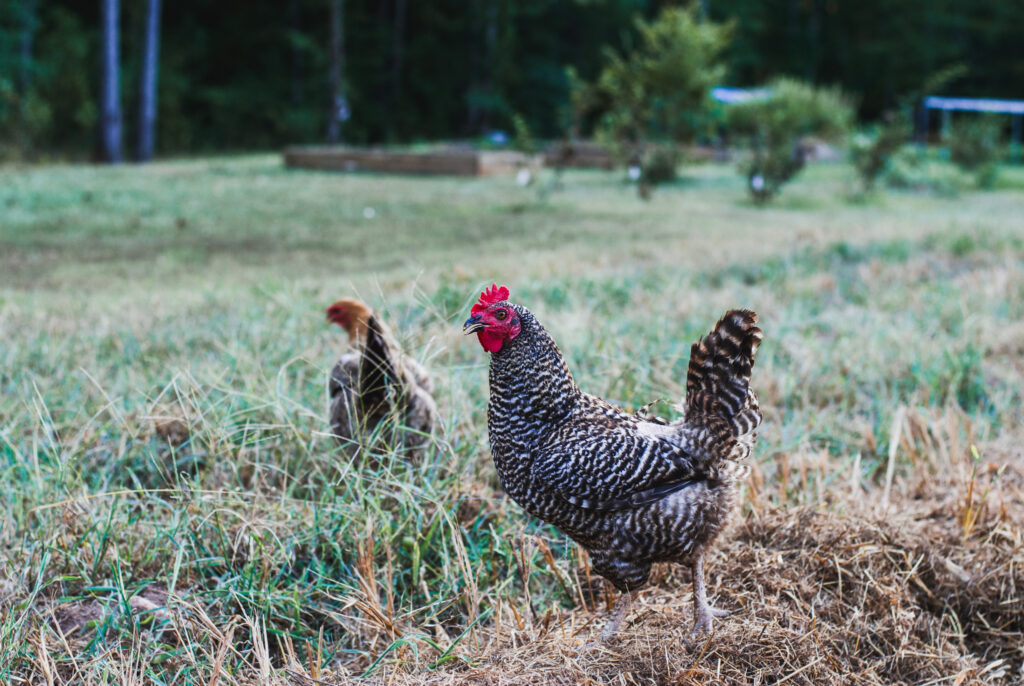
Health Issues
Barred Rocks are known for being hardy birds, which is one of the reasons I love them so much. Some research even suggests that they are more resistant to Marek’s disease than other chickens.
However, like any breed, they can still face health issues. In very hot climates, Barred Rocks are at risk for heat strokes, so they need to be monitored closely during the hottest days. They can also suffer from common chicken problems like mites, intestinal parasites, and vent gleet.
I once had a Barred Rock chicken get a severe respiratory illness, but with some care, she recovered fully, showing just how resilient these birds can be. Their overall hardiness is definitely a standout trait, making them a great choice for any flock.
Barred Rock Chicks
Barred Rock chickens are known for being broody, but when they do sit, they make excellent mothers. One of the interesting things about Barred Rock chicks is that they are sex link chicks. This means you can easily tell the difference between males and females while they’re still young.
Male Barred Rock chicks have a double copy of the barring gene, which makes them a lighter color, with more noticeable white bars, while females have a smaller light spot on their heads. These tell-tale signs make it easy to distinguish between the two.
Barred Rock chicks are also hardy and easy to brood, making them a great choice for both beginners and experienced chicken keepers. If you want to learn more about broody chickens, be sure to check out my previous post on the topic.
History of the Barred Plymouth Rock
Barred Rock chickens have a rich history as one of the oldest heritage breeds in the United States. The Barred Plymouth Rock was the original variety, and it first appeared in Massachusetts in the late 1800s. Over time, six other varieties of Plymouth Rock chickens were developed, but the Barred Rock remains the most well-known.
There’s even a bantam version of the Plymouth Rock chicken for those who prefer smaller birds in their backyard chicken flocks. This dual-purpose heritage breed has stood the test of time and continues to be a favorite for first-time chicken keepers and seasoned pros alike. If you’re curious about bantam chickens, check out my previous post for more details!
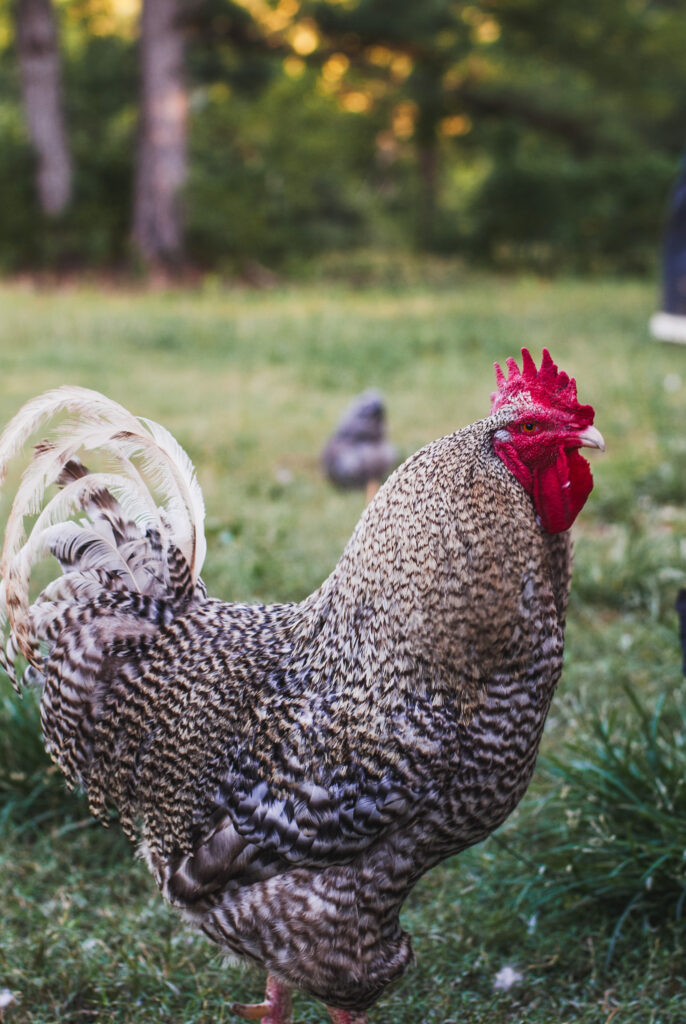
Why you’ll love this breed
Let’s review all the reasons why you’ll love barred rock chickens!
- Hardy and Resilient: Barred Rocks are tough birds that handle various climates well, from hot summers to cold winters.
- Great Layers: They consistently produce around 200-250 medium to large brown eggs a year, and some even lay during the winter months.
- Dual-Purpose: These birds have full bodies of tender meat, making them great for both egg and meat production.
- Heritage Breed: As a heritage breed, they mate naturally, have a long lifespan, and stay true to their genetics.
- Excellent Mothers: While they can be broody, Barred Rock hens make wonderful mothers when they decide to sit on a nest.
- Sex Link Chicks: It’s easy to tell males from females when they’re young, thanks to their distinct barring patterns.
- Calm and Curious: Their friendly and curious nature makes them great for backyard flocks.
- Classic Appearance: With their striking black, white, and gray barring and bright red combs, Barred Rocks are beautiful, noble-looking birds.
- Hardy Chicks: Barred Rock chicks are easy to brood and thrive in different environments.
- Long History: As one of the oldest heritage breeds in the U.S., they bring a bit of history and tradition to your flock.
FAQs
How long do Barred Rock chickens live?
Barred Rocks can live up to 8-10 years with good care, sometimes even longer.
Are Barred Rocks friendly with other chicken breeds?
Generally, yes! They’re calm and get along well with other breeds, though they might assert dominance in mixed flocks.
Do Barred Rock chickens fly?
They’re not great fliers due to their heavy bodies, so they usually stay close to the ground. A 4-6 foot fence should keep them in.
How big do Barred Rocks get?
Hens typically weigh around 6-7 pounds, and roosters can reach 7-8 pounds.
Are Barred Rocks good for beginners?
Absolutely! Their hardy nature, friendly disposition, and ease of care make them a perfect choice for first-time chicken keepers.
How much space do Barred Rocks need in a coop?
Aim for at least 4 square feet per bird in the coop, more if they don’t have access to outdoor space.
Do Barred Rocks do well in confinement?
While they can tolerate confinement, they’re happiest when they have room to roam and free-range.
What colors do Barred Rocks come in?
The standard Barred Rock has that classic black, white, and gray barring pattern, but there are other varieties of Plymouth Rocks in different colors.
Are Barred Rocks noisy?
They can be vocal, especially when laying or if something excites them, but they’re generally quieter than some other breeds.
What do Barred Rock chicks look like when they hatch?
Barred Rock chicks are usually black with white spots on their heads, making them easy to distinguish from other breeds.
My Chicken Must-Haves!
- Automatic Chicken Coop Door
- 50 Pound Capacity Chicken Feeder
- Chicken Vegetable Hanging Feeder
- Heavy Duty Free-Standing Chicken Feeder-(perfect for when you travel!)
- Automatic Livestock Waterer
- VetRx Poultry Aid
- HenGear Nesting Boxes
When Do Barred Rock Chickens Start Laying Eggs? –Final Thoughts
Barred Rock chickens are a fantastic choice for any backyard flock. They’re hardy, friendly, and great for both eggs and meat, making them a perfect dual-purpose breed. With their striking black and white feathers, calm disposition, and excellent mothering skills, it’s easy to see why they’re such a popular breed.
Whether you’re a beginner or an experienced chicken keeper, Barred Rocks are sure to win you over with their consistent egg production, resilience, and rich history as one of America’s oldest heritage breeds. Plus, with their ability to thrive in various climates and their easy-to-raise chicks, they truly stand out as one of the best choices for any chicken lover.
If you enjoyed this article on chickens, please share it!
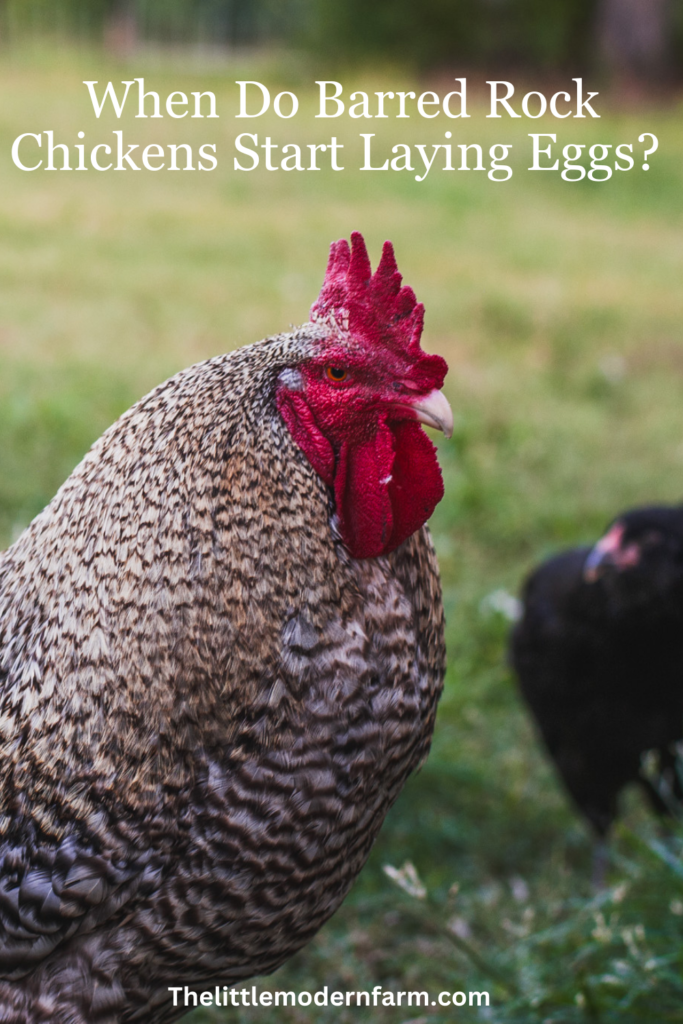
More from the farm
What is the best animal to protect chickens? Keeping backyard chickens safe from potential predators like birds of prey and raccoons can be a real challenge. These predators are clever, always on the lookout for an easy meal.
However, certain guard animals can help keep your flock safe. By choosing the best animal to protect your chickens, you can keep those sneaky predators at bay and give your birds a much better chance at living a long, happy life.
The Lord is good to all and compassionate to every creature. -Psalm 145:9
[…] being friendly and having good egg layers. If you’re raising Barred Rocks, you might be wondering when Barred Rock chickens start laying eggs. Typically, these chickens begin laying eggs around 18 to 20 weeks of […]